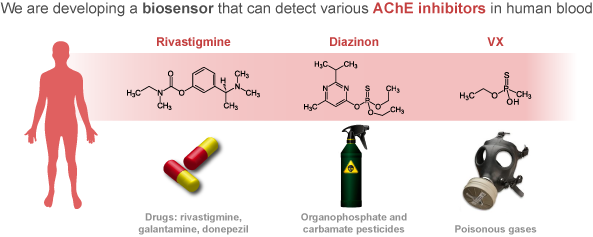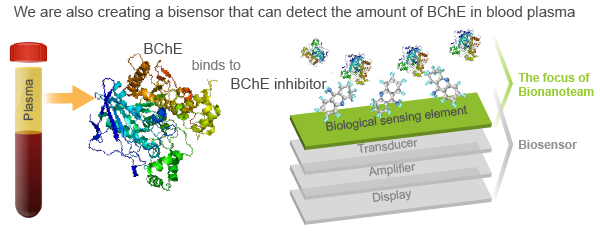Development of biosensors for cholinesterases (ChEs) stems from our research of neuronal and non-neuronal cholinergic system in different organisms, organs and cells under normal, stress and pathological conditions.
Cholinesterases as biomarkers
There are different types of ChEs:
- neuronal/non-neuronal;
- membrane bound/soluble;
- different splice variants;
- with classic/non-classic function.
Different types of ChEs or their activity provide information on the:
- progress of neurodegeneration: very early stages of neurodegeneration could be detected by the ratio between diffrent types/isoforms of ChEs;
- stress response: multiple stress stimuli increase the ratio between AChE-R and AChE-S in brain and blood cells alike;
- infection/immune response, etc.
Acetylcholine depletion, alterations in acetylcholinesterase (AChE) and butirylcholinesterase (BChE) as well as a combined use of these two markers can serve in the detection of patients with neurodegenerative diseases. In the future, different types and isoforms of ChEs has a potential to be used as an early diagnostic biomarker of Alzheimer’s or Parkinson’s disease along with other markers (blood parameters, EEG, behavioural changes etc.).
Moreover, AChE and BChE represent therapeutic targets for ameliorating cholinergic dysfunction associated with the cognitive and behavioral abnormalities in dementing illness.
Development of cholinesterases-based biosensors
ChE-based sensors already exist and are used for carbamate and organophosphorous pesticides. Existing ChE sensors have to be upgraded in terms of sensitivity and specificity, signal transduction and data processing.
Our aims are:
- to measure the activity of different types of ChEs in different fluid samples (blood, synovial fluid, cerebrospinal fluid, etc.) and link this data with other measured endpoints (e.g. blood parameters, EEG signal);
- to develop a biomarker approach based on differential expression of ChEs isoforms in body fluids for the detection of pre- and neurodegeneration stages;
- to develop isoform-specific ChE inhibitors: anionic or the esteratic (catalytic) substances;
- to establish psychotropic/psychodynamic efficiency of isoform-specific ChE inhibitors;
- to develop bionanosensors based on ChE enzymes (to detect their inhibitors, e.g. ChE-inhibiting drugs) and ChE inhibitors (to detect enzymes, e.g. BChE).
Contributions to society
- Bio-nanosensors for early stage of neurodegenerative diseases.
- Point-of-care diagnostic tools.
- Personalised medicine.
- Better understanding of the treatment success rates and wellness attribution of patients, which would result in the creation of statistically-driven medical care guidelines or protocols.
- Actuarial analytical techniques and healthcare-related business knowledge are critical elements to understanding the business and consumer aspects associated with clinical effectiveness of care.


